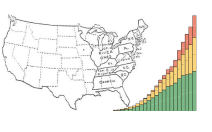Limiting the length of the Chartbook, as described above, requires some choices regarding four parameters: geographic detail, topics, cross tabulations, and census years. For example, graphics showing data down to the county level (which still would not include data for individual cities) for all topics in the decennial census of population for all years (1790 to 2000) with extensive cross-tabulations (e.g., by type of residence and by race and Hispanic origin) would require several hundred thousand pages.
The geographic coverage in the Chartbook is primarily for the United States and for regions (North, South, and West, as discussed below). In addition, data are shown on some topics for states and for the ten largest cities and the ten largest metropolitan areas in the United States.
The Census Bureau designations of subnational regions (based on aggregations of states) has changed over time (Dahmann, 1992; Hindman, 2006). The four regions used currently by the Census Bureau are the Northeast, Midwest, South, and West; however, it is preferable here to use the three regions listed in the preceding paragraph for geographical, historical, and demographic reasons. These three regions are much more similar in land area (representing 25.5 percent, 24.6 percent, and 49.6 percent, respectively of U.S. land area in 2000) whereas the Northeast represents only 4.6 percent of U.S. land area.[7] The major conflicts in American history reflect North-South comparisons more than Northeast-Midwest comparisons.[8] Historical differences between the North and the South are much greater than between the Northeast and the Midwest for a wide range of demographic characteristics, including, for example, population growth rates, urbanization, racial composition, educational levels, and the proportion foreign born.
Geographic detail is shown for the United States as defined at each census. This includes the enumerated area of the conterminous United States and includes territories, which frequently had very different boundaries than states subsequently created from them. Alaska and Hawaii, being outside the conterminous United States, are included first in 1960. Important changes in state boundaries include the creation of the District of Columbia from parts of Maryland and Virginia in 1791, the retrocession of the Virginia portion of the District of Columbia in 1846, and the creation of West Virginia from part of Virginia in 1863. The Oklahoma Territory and the Indian Territory, shown for the only time in the census in 1900, were merged to form the state of Oklahoma in 1907.[9] Prior to 1890, the enumeration of the American Indian population in the decennial census excluded those living in tribal society (the large majority of the Indian population), and information on the full range of census items was not collected for the American Indian population until 1900.
Three maps are included for use with the graphics. Map 1 and Map 2 show states and territories for the 1790 to 1840 period and the 1850 to 1900 period, respectively (after which no major changes in boundaries have occurred in the conterminous United States, except as noted above for Oklahoma). Map 3 shows the United States by census region, census division, and state in 2000.
Because the focus here is on American demographic history for the full 1790 to 2000 period, the topics included are limited to those for which information has been collected, or is derivable from the information collected, in the decennial census for at least a century and reflect some judgment about what topics are of most general interest. The topics included are indicated in the chapter titles. In two cases, presentation of data on a topic reflects a change in the census item. Educational level was measured by illiteracy rates (i.e., from a negative perspective) prior to 1940, by years of school completed from 1950 to 1980, and primarily by educational diplomas and degrees in 1990 and 2000. Fertility was first measured by children ever born in 1910; however, child-woman ratios can be calculated using data on age and sex back into the 19th century.[10]
With a few exceptions, the topics shown in the graphics are not cross-tabulated by other characteristics, for reasons of space. The primary exception is that some social and economic topics (e.g., marital status and labor force participation rates) are shown by age and sex, which are of fundamental importance in demographic analysis.[11] In general, data are not shown by race or Hispanic origin, except for censuses prior to 1870 when data on some topics were collected only for the White population or for the free population. For many topics, data are available in decennial census publications on population characteristics down to the state level by type of residence (e.g., urban and rural) and to the county level.
At the national level, the graphics show data for every census year for which data are available in the 1790 to 2000 period. With a few exceptions, data are shown at the regional and state levels only for selected years. In general, these years are 1790 (the first census) 1820, (about midway between 1790 and 1860, and following the effects of the War of 1812), 1860 (on the eve of the Civil War), 1900 (turn of the century), 1940 (on the eve of World War II and the baby boom), 1970 (end of the baby boom and the beginning a new wave of large-scale immigration), and 2000 (turn of the century).
[7]U.S. Census Bureau, 2004.
[8]This is reflected in textbooks on American history. For example, see Kennedy, Cohen, and Bailey, 2010.
[9]For a description of boundary changes, as well as historical population counts for states and counties, see Forstall, 1996.
[10]For a comprehensive list of items on the population questionnaire at each decennial census in the 1790 to 2000 period, see Gauthier, 2002.
[11]Hobbs, 2004.
